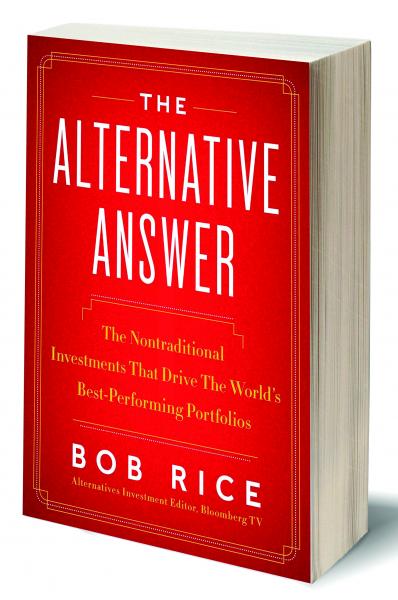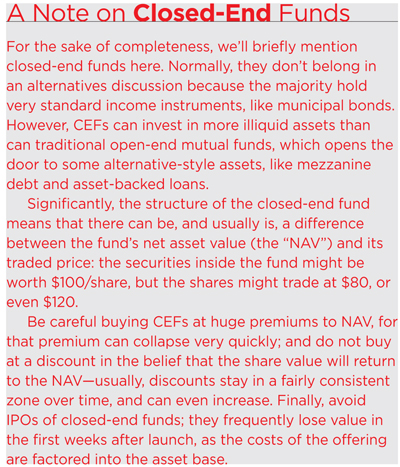Form ever follows function.—Louis Sullivan
Liquid alternatives are a revolutionary advance for average investors. The term refers to alternative assets and strategies that are packaged up inside mutual funds, ETFs, publicly traded partnerships and a few other vehicles that can be bought by anyone and either sold or redeemed at any time.
Many alternative income-generating products come in these packages. As compared to traditional fixed income products, these can provide higher yields, inflation protection and tax benefits. Another group of liquid alternatives, most famously the gold ETF, offers exposure to real assets that most investors would otherwise find impossible to hold.
But the most exciting, and rapidly developing, branch of liquid alternatives is the “smart beta” category, which provides easy, low-cost access to traditional hedge fund strategies.
 They’re “smart” because they limit risk. The category is dominated by long/short stock strategies that should comfortably outperform long-only strategies during choppy and down markets.
They’re “smart” because they limit risk. The category is dominated by long/short stock strategies that should comfortably outperform long-only strategies during choppy and down markets.
Other styles provide noncorrelation: managed futures, various arbitrage strategies, global macro and even currencies. All are extra smart because the fees associated with them are typically far less than those charged by the traditional privately placed funds that historically ran these strategies.
They’re “beta” because … well, that’s what you’re going to get. It’s a great marketing pitch to say you’re running a hedge style in a large, liquid fund, but investment style alone most certainly does not generate alpha. Investors in most “alternative” mutual funds and ETFs should simply not expect to see it—it is essentially impossible to generate alpha at scale, with total liquidity, within tight constraints on asset classes, strategies … and manager fees.
Now, you might just be thinking, wait, isn’t beta exactly what I don’t want to pay for? But here we’re talking about strategies that provide powerful risk-adjusted exposure to the stock market and powerful diversification benefits. That’s worth paying (something) for … what you do not want to do is pay for alpha and get beta. With these, you don’t.
Just as with privately placed alternatives funds, managers matter hugely in liquid alternative products, much more than they do in the long-only world. Of course, even great strategy doesn’t do you much good if there’s a mediocre team executing it. And, given the recent breakneck race toward liquid alternatives, the manager quality level is bound to be uneven. So avoid swooning over the general description and drill down on the track record. With any alternative product, performance statistics are more important than a brand name.
Also, recall that there are many alternative strategies that are simply beyond the reach of mutual funds and ETFs, which face legal limits on use of leverage, short selling and holding illiquid assets. In addition, liquidity requirements preclude smart beta products from pursuing some strategies that just take time to work, like distressed or activist investing, and also from pursuing private equity and real asset styles.
Traditional Private Placements
As mentioned in the previous chapter, hedge, private equity and venture capital strategies have historically been available only through “private placements” of limited partnership interests. That’s the biggest reason why they’ve seemed so exotic: they were, effectively, doubly unavailable to average investors.
First, private placements were indeed private, and couldn’t be generally advertised or offered to the public … they could be exposed only to wealthy individuals who already had a relationship with the fund managers or brokers. So unless you were a select member of a pretty fancy circle, you would never have known they existed. It wasn’t until 2012 that legislative changes eliminated this restriction. That’s why you’re seeing ads for these things now, but never did before.
But maybe not hearing about them was no real loss …they usually required huge minimum investments, sometimes as much as $10 million, and were typically sold only to “qualified purchasers,” institutions and individuals with a $5 million net worth. Even now, after all the recent changes, private placements can still be purchased only by “accredited investors,” generally those with a $1 million net worth excluding their residence. Secret deals with huge capital commitments: not exactly for the Elks Club.

Nonetheless, hedge funds rocketed in the ’90s as the technology and communications revolutions made arbitrage opportunities between world markets easier to see and exploit. To take full advantage, you needed really smart people, some computers, not too much regulation, and lots of leverage … and all were present. The combination generated volcanoes of money, to which rich folks, as is their wont, gravitated rapidly. The clubby exclusivity only made the game more appealing.
That, in turn, led to a talent exodus from the traditional Wall Street institutions that still stings. After all, why work at some schleppy bank for a few hundred thou when you could make tens of millions, or more, managing a hedge fund? That is why, today, we have those 9,000 hedge funds of this traditional “private placement” kind (and maybe 7,000 too many). That is also why privately placed funds is where you’ll find the most talented money managers in the world.
Private placements certainly have drawbacks. Beyond that famous fee structure, they usually require some sort of minimum investment period, or lockup, and may also have gates that prevent investors from leaving even after that period expires.
Moreover, as you no doubt are aware, privately placed hedge funds haven’t exactly been the darlings of the media lately, and for good reason: some high-profile insider trading cases and, rarely but spectacularly, episodes of outright fraud. (Frankly, not so surprising when you think about it: combine enormous money and utter secrecy and you have con artist heaven.) The reality, however, is that such issues shouldn’t overly worry reasonably careful investors. As a practical matter, totally standard due diligence tips (like, ensuring the fund’s assets are held by an independent custodian, and that top accounting and law firms are involved) provide solid protection. In addition, the Dodd-Frank Act now requires that most managers register with the SEC, which has begun monitoring and auditing them.
From THE ALTERNATIVE ANSWER by Bob Rice © 2013 Bob Rice. Reprinted courtesy of Harper Business, an imprint of HarperCollins Publishers.






